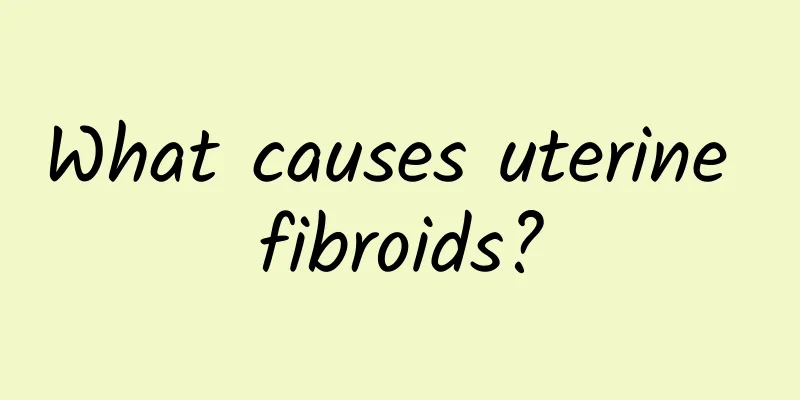What causes uterine fibroids?

|
Uterine fibroids may be the result of multiple factors, including genetics, environmental factors, abnormal hormone levels, uterine tissue damage or inflammation. Identifying the cause will help to better prevent and treat it, which can be started from regular physical examinations, weight control and improved lifestyle habits. 1. Genetic factors: The onset of uterine fibroids is often closely related to heredity. If there are female relatives in the family who suffer from uterine fibroids, such as mothers or sisters, the probability of getting the disease may be relatively higher. Studies have found that some gene mutations may increase the abnormal division of uterine smooth muscle cells, causing fibroids to gradually form. If there is a related medical history in the family, it is recommended to pay attention to your own health as early as possible and undergo regular gynecological examinations. 2 Environmental factors: Long-term exposure to some environmental pollutants may promote the occurrence of uterine fibroids. For example, certain chemicals or hormone disruptors can affect the balance of hormone secretion in women and interfere with the normal environment of uterine smooth muscle cells. In life, we should try to avoid contact with harmful chemicals, such as plasticizers, polycyclic aromatic hydrocarbons and certain pesticides. High-pressure urban life, staying up late, improper diet, etc. can also induce the development of the disease. 3 Physiological factors: Abnormal fluctuations in the levels of estrogen and progesterone in women are one of the most common causes of uterine fibroids. Estrogen and progesterone can promote the growth of uterine smooth muscle cells, and when smooth muscle cells divide excessively, they can lead to abnormal tissue proliferation and form fibroids. This situation is common in women of childbearing age, especially those with high hormone secretion, irregular menstrual cycles, obesity or polycystic ovary syndrome. 4 Traumatic or pathological factors: If there has been a history of intrauterine manipulation, such as abortion curettage, hysteroscopy or surgery, human interference may lead to a disorder in the repair of uterine tissue cells, which in turn may induce fibroids. At the same time, chronic uterine inflammation or uterine blood supply disorders may also cause fibrosis and lesions in the uterine myometrium, thereby triggering the formation of fibroids. Prevention and treatment can be considered from the following aspects: 1. Drug treatment: For example, the use of the progesterone antagonist mifepristone or the gonadotropin-releasing hormone agonist goserelin to control fibroid growth and improve symptoms. 2Surgical treatment: For patients with larger uterine fibroids or those that cause obvious symptoms, laparoscopic myomectomy, uterine artery embolization or hysterectomy can be selected. 3 Daily conditioning: Maintain a healthy diet and reduce the intake of high-fat and high-sugar foods; exercise more to control weight; undergo regular gynecological ultrasound examinations to monitor changes in fibroids in a timely manner. In order to better protect the health of the uterus, it is recommended that female friends maintain good living habits and undergo regular gynecological examinations. If abnormal symptoms such as menstrual disorders, excessive menstrual flow, or unexplained abdominal distension occur, you should seek medical attention in time for a clear diagnosis and never ignore the body's warning signals. |
<<: Why does my right leg hurt more and more due to adenomyosis?
>>: What medicine should I take for right ovarian cyst
Recommend
What are the signs of ectopic pregnancy?
Ectopic pregnancy refers to the fertilized egg be...
Supermodel Akemi wears slimming pants to lose weight and suffers from skin rash and allergies
In order to maintain their good figures, many fem...
What is the problem with female friends suffering from adnexitis?
What is the problem with female friends suffering...
What are the dangers of having an IUD inserted directly after an abortion? 3 dangers of having an IUD inserted directly after an abortion
Whether an IUD can be inserted directly after an ...
How long after myomectomy can I get pregnant
It is generally recommended to wait 6 months to 1...
The dangers of surgery for hyperprolactinemia
If hyperprolactinemia is pathological, it is a di...
What are the hazards of female cervicitis and how to treat female cervicitis
Cervicitis is common in women of childbearing age...
No plastic surgery required! Fight sagging buttocks with these 5 tricks
No plastic surgery required, these exercises desi...
How to take care of senile vaginitis?
Senile vaginitis is a type of vaginitis, and the ...
What are the symptoms of pelvic effusion?
Pelvic effusion is the presence of inflammatory e...
Common complications of irregular menstruation
Irregular menstruation is a common gynecological ...
Does uterine fibroids require hysterectomy? Under what circumstances is minimally invasive surgery for uterine fibroids necessary?
Uterine fibroids are a common clinical disease, a...
Wake up those lazy muscles! Practice these 3 TRX moves quickly and your abdominal muscles will not be wasted!
The "abdomen-showing era" has arrived. ...
Can naked flower purple bead capsule treat pelvic inflammatory disease? It can also treat
After pelvic inflammatory disease occurs, you can...
How to develop beautiful legs! 3 Yoga Moves to Show Your Absolute Domain
It’s not difficult to have a pair of “pencil” leg...









